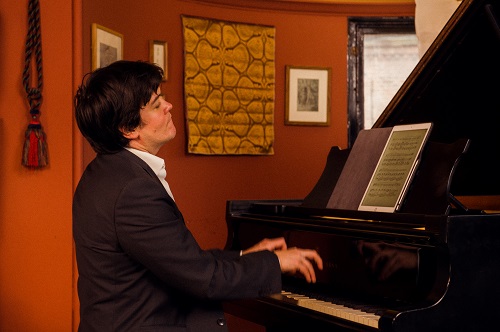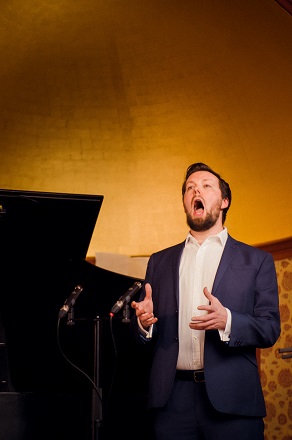The Rossetti family, according to William Michael, in Some Reminiscences (1906), ‘were not a musical family; they had no gift in that direction … no craving to be constantly hearing music’. Some have assumed that this means that William Michael and his siblings, Christina and Dante Gabriel, had little interest in music. And, yet, a close look at the latter’s poems and paintings reveals much musical imagery and symbolism, and frequent scenes in which music is heard or imagined. It is the process by which music is made, experienced and understood – a process which brings together composer, performer and listener – that seems Rossetti’s chief concern, and it is a process that he seeks to re-enact within his own poetry, or ‘song’.
During the first years of the twentieth century, Ralph Vaughan Williams worked on three substantial songs cycles that were to become some of his first published compositions. Songs of Travel (1904), setting poems by Robert Louis Stevenson, is today the best known of these. The other two cycles set poems selected from Dante Gabriel Rossetti’s extended sonnet sequence, The House of Life. First came Willow-Wood, a cantata for baritone, women’s chorus and orchestra which was published in 1903 and which the composer revised six years later. The House of Life: A Cycle of Six Sonnets was published in 1904 and received its first performance in December of that year.
In the untitled sonnet which prefaces the sequence of 101 poems, Rossetti described the sonnet form as ‘a moment’s monument’; the poet, or ‘Singer’, to use Rossetti’s own term, progresses through the ‘house of life’, moving from a physical and essentially solipsistic desire towards a spiritual union between the ‘self’ and the ‘other’, not only in life but also in love. In selecting six of these sonnets for his song-cycle, Vaughan Williams thus presents poetic ‘moments’, ‘snapshots’ of love – a love that is transformed from the erotic and sensuous into the spiritual and ideal.
At Leighton House Museum, the former home and ‘private palace of art’ of painter-collector Frederic Leighton (1830-96) – and a building which was described by William Michael, in a letter to his wife Lucy in 1882, as ‘a gorgeous specimen of oligarchical luxury’ – Opera Holland Park presented a recital of Vaughan Williams’ A House of Life by tenor David Butt Philip and pianist James Baillieu.

Vaughan Williams is to some extent obliged to observe the processes of the sonnet form, and he closely observes the divisions of the octet and sestet in Rossetti’s poems, which are usually divided by a piano interlude, and frames the fourteen lines of poetry with an introduction and postlude. The first song, ‘Love-Sight’, begins with a piano ascent reflecting the poet-singer’s search for ‘self’ in the reflection of his beloved:
When do I see thee most, beloved one?
When in the light the spirits of mine eyes
Before thy face, their altar, solemnize
The worship of that Love through thee made known?
James Baillieu sculpted the rising scale with Schumannesque delicacy, the warm consolations of the mirroring descent intimating the possibility of a true union between the divided figures. David Butt Philip captured the youthful ardency, and naïve narcissism, of the Singer, rising to a charged peak at the close of the octet: “Close-kissed and eloquent of still replies/ Thy twilight-hidden glimmering visage lies,/ And my soul only sees thy soul its own?” His tone was strong and his diction natural in the subsequent complexities of thought which wrack the young man, concerned that, should he no more gaze upon the beloved, the ‘perished leaves of Hope’ which struggle to ‘sound upon Life’s darkening slope’. The return of the intimate tone and gentle rocking of the introduction, in the piano postlude, suggested that such fears were somewhat self-indulgent and misguided.
‘Silent Noon’ is the best-known song of the cycle. It portrays a pastoral paradise in which the lovers nestle in ‘golden kingcup fields with silver edge/ Where the cow-parsley skirts the hawthorn hedge’. A steady tempo, relaxed syncopation and repeating motifs conjured the stillness of the moment – neither the landscape nor time itself seem to move – a stillness which culminates in an image of art’s silent perfection, and which Vaughan Williams marks with a delicious harmonic slippage which was wonderfully exploited and coloured by Baillieu and Butt Philip: “Tis visible silence, still as the hourglass.” The freedom and fluency of Butt Philip’s recitative further held time suspended: “Deep in the sun-searched growths the dragonfly/ Hangs like a blue thread loosened from the sky.” Nature and art were fused, and the return of the opening melody – a rare feature within the sequence the songs of which tend to journey progressively to more complex realms – strengthened the sense of permanence. The final Keatsian paradox of the “close-companioned inarticulate hour/ When twofold silence was the song of love” was broad and confident, Butt Philip’s head voice both gentle and true.
In ‘Love’s Minstrels’, titled ‘Passion and Worship’ by Rossetti, the poet presents his philosophy of warring love and faith, bringing about a distinct change of tone which Vaughan Williams matches. The harmonic and textural juxtapositions of the piano introduction intriguingly embodied the musical rivalry of ‘Passion’ – the Singer’s masculine, mastering music – and white-winged ‘Worship’, with its trembling harp. Butt Philip was a persuasive storyteller, capturing the mystery of the ethereal harp-player and the fervency of the Singer. There was almost Brittenesque directness in the responsiveness of the flexible vocal idiom to the dramatic contingencies of the text, and the Lady’s own words had powerful rhetorical grandeur, the harmonies seeming to quiver and ripple between the sensuously expressive colours.

‘Heart’s Haven’ is more conventionally rapturous and Romantic, however, and Butt Philip enlarged the canvas to quasi-operatic proportions here, though he did not neglect the intimacy of images of shelter and peace as the Singer craves “the refuge of her deep embrace,/ Against all ills the fortified strong place/ And sweet reserve of sovereign counter-charms”. The musical imagery, vocal expanse of the closing tercet – as Butt Philip melted to the sweetest pianissimo then rose in confident declarations – seemed to make happiness assured, as confirmed by the consonant carillon of the piano’s postlude:
Like the moon’s growth, his face gleams through his tune;
And as soft waters warble to the moon,
Our ans’ring spirits chime one roundelay.
Earthly love is mutable in the ambiguous ‘Death-in-Love’, in which hopes of earthly paradise are surrendered and the eponymous mythical persona confronts the Singer. Baillieu and Butt Philip summoned an almost Wagnerian melodramatic stature to convey the disorder wreaked by the ‘veiled woman’ who ‘plucked a feather from the bearer’s wing,/ And held it to his lips that stirred it not,/ And said to me, “Behold, there is no breath:/ I and this Love are one, and I am Death.”’
But, in the final song, ‘Love’s Last Gift’ is revealed to be ‘this laurel’ – Rossetti’s sonnet sequence, Vaughan Williams’ music, and the Singer’s song. There was reassuring resolution in the forthrightness of the Sine Nomine melody with which the song begins, as Rossetti makes a religion of beauty, and Love invites the Singer to sing its very essence, ‘Take my last gift; thy heart hath sung my praise’, an invitation accepted with lovely lyrical conviction by Butt Philip
But, since the text of the song comprises Love’s words, the Singer is not just the performer of that song, but the listener, audience, too. Vaughan Williams’ song is about both making and hearing music, since Rossetti envisions art as something that requires an audience for its completion. After all, in Pater’s view the ‘condition’ of music to which all other arts aspire is its temporality which embodies the listener’s own experience of time and consciousness. As Vaughan Williams himself observed in his 1912 essay, ‘Who Wants the English composer?’, the ideal union of composer-performer-listener, was for the latter to become aware that ‘the composer is their own voice speaking through his art.’
This performance of The House of Life is available to watch on demand until 30th April, with a suggested donation of £5.
Claire Seymour
Opera Holland Park: David Philip Butt (tenor), James Baillieu (piano)
Leighton House Museum, Holland Park, London (recorded streamed performance); Tuesday 13th April 2021.